Updated: January 31, 2025
Why can you trust us?
Radon is a gas formed by decomposing uranium, occurring naturally in igneous rock and soil. It has no taste, odor, or color and cannot be detected without testing. Because radon is radioactive, it can cause lung cancer in people exposed to it for several years. It enters your home naturally as the soil or rock beneath it breaks down. According to the EPA, radon gas is the second leading cause of lung cancer in the United States after cigarette smoke.
The national average cost to test your home for radon is $650 to $2,850, with most homeowners paying $1,700 for professional continuous alpha particle testing of the home for 48 hours with analysis and passive depressurization to mitigate the radon. This project’s low cost is $600 for a passive charcoal test with professional analysis and lower-level pressurization for mitigation. The high cost is $5,900 for 90 days of continuous active digital testing with professional analysis, and active suction and basement sealing for mitigation.
Radon Testing Price
| Radon Testing Cost | |
| National average cost | $1,700 |
| Average range | $650-$2,850 |
| Low-end | $600 |
| High-end | $5,900 |
What Is Radon?
Radon is a naturally occurring gas produced as uranium breaks down in the soil, and this happens worldwide. Your home may suck in radon gas through foundation cracks or wall gaps because your home’s air pressure is usually lower than the soil around it.
Drinking water sourced from a well might be another source of radon because the particulates can contaminate well water and disperse it around the home. There are even situations where radon is present in the construction materials used to build a home, but this is rare.
Radon Levels by State
Radon is present in all 50 states of the U.S. Some areas generally have much lower levels than others, with some states having consistently higher levels and others having varying levels across the state. It is recommended that you have regular testing if you live in a state or county with levels of at least 2 pCi/L or higher. States with levels of 4 pCi/L or higher may also have regulations requiring regular testing and potential mitigation systems installed with new homes. Even if your state has low levels, those levels can fluctuate by county and house lot. Your neighbor may have low levels while you have high levels, so test periodically if levels in your state average about 2 pCi/L. Below are the average levels for each state in the U.S.

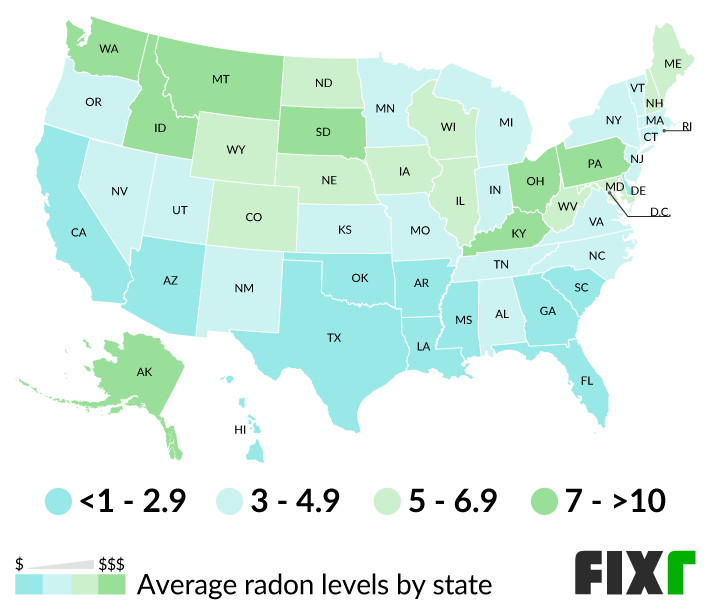
| State | Average Radon Levels |
| Alabama | 3.9 |
| Alaska | 10.7 |
| Arkansas | 2.5 |
| Arizona | 1.9 |
| California | 2.3 |
| Colorado | 6.8 |
| Connecticut | 3.4 |
| Delaware | 2.4 |
| Florida | 1.8 |
| Georgia | 2.3 |
| Hawaii | <1 |
| Idaho | 7.3 |
| Illinois | 5.3 |
| Indiana | 4.7 |
| Iowa | 6.1 |
| Kansas | 4.9 |
| Kentucky | 7.4 |
| Louisiana | 1.1 |
| Maine | 5.9 |
| Maryland | 5.4 |
| Massachusetts | 3.9 |
| Michigan | 3.5 |
| Minnesota | 4.6 |
| Mississippi | 1.2 |
| Missouri | 4.3 |
| Montana | 7.4 |
| Nebraska | 5.2 |
| Nevada | 3.4 |
| New Hampshire | 5.6 |
| New Jersey | 4.4 |
| New Mexico | 3.9 |
| New York | 4.2 |
| North Carolina | 4 |
| North Dakota | 6 |
| Ohio | 7.8 |
| Oklahoma | 2.5 |
| Oregon | 3.1 |
| Pennsylvania | 8.6 |
| Rhode Island | 4.3 |
| South Carolina | 2.4 |
| South Dakota | 9.6 |
| Tennessee | 4.8 |
| Texas | 2.1 |
| Utah | 4.4 |
| Vermont | 3.7 |
| Virginia | 3.6 |
| Washington | 7.5 |
| Wisconsin | 5.7 |
| West Virginia | 6.1 |
| Wyoming | 5 |
Radon Testing Prices by Type
Radon testing determines the presence of radon in your home and calculates how much radon you have. Four or more picocuries per liter (pCi/L) is classed as a high reading of radon, and various test types can figure out how much radon you have. Many radon tests are available at big box stores or through your state. These are designed to be DIY over a few days or several months.
DIY testing can be done anytime, but you should follow this with professional testing if you get a high result. The times you may want to test include if you notice new cracks in your foundation, which could allow radon into your home, or if you have neighbors who have recently had high testing. In some states, it is also recommended that homeowners test every 2 to 5 years because levels can change. It is also recommended that you get professional testing done if you purchase or sell a home. The table below shows some tests and their average costs:
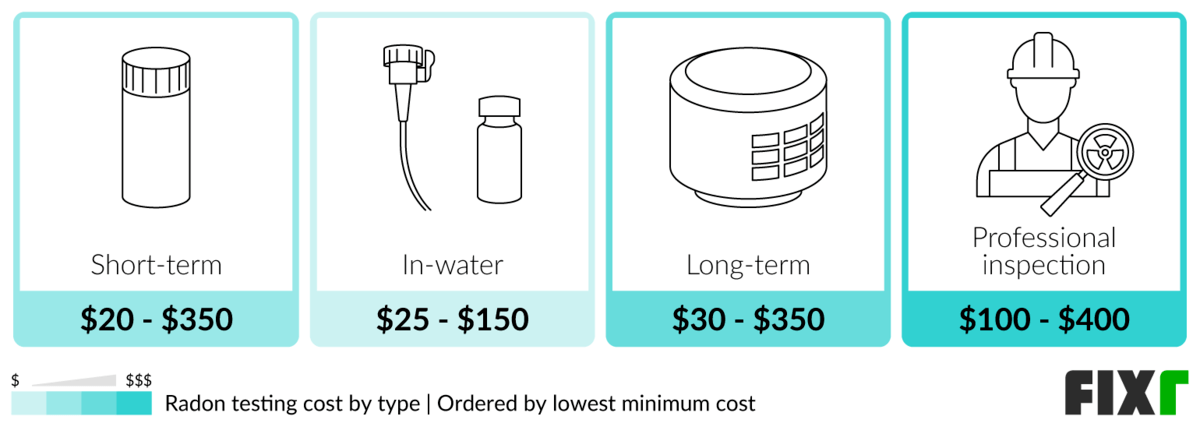

| Type | Test Cost |
| Short-Term | $20 - $350 |
| In-Water | $25 - $150 |
| Long-Term | $30 - $350 |
| Professional Inspection | $100 - $400 |
Short-Term Radon Testing
Average costs for short-term testing range from $20 to $350. Short-term kits are the fastest way to check for radon in your home or workplace. They come in various forms, typically only needing 2 to 3 days for results, but some devices stay up to 90 days. A short-term test can tell you if radon is present but is less accurate than a long-term alternative because radon levels vary. You can use short-term tests in different ways for more accuracy, such as running two tests at the same time or running one after another for a longer-term average. The testing results are included in the cost of the kit. Below are the various short-term tests.

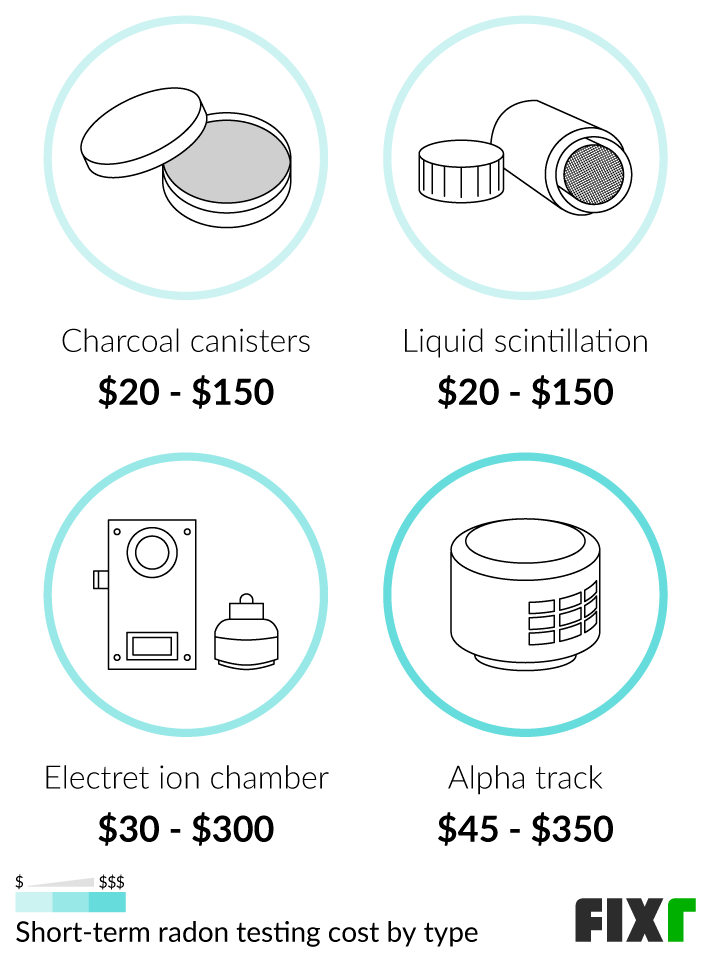
| Type of Short-Term Testing | Cost |
| Charcoal Canisters | $20 - $150 |
| Liquid Scintillation | $20 - $150 |
| Electret Ion Chamber | $30 - $300 |
| Alpha Track | $45 - $350 |
Charcoal Canister Radon Test
A charcoal canister test costs $20 to $150. Charcoal canisters contain activated charcoal, the main ingredient for radon testing. Charcoal absorbs radon from the air and must be analyzed in a lab to understand how much radon was absorbed and estimate the amount of radon in the home. Charcoal canisters are passive short-term radon testing kits, meaning they do not need electricity.
Liquid Scintillation Radon Test
A liquid scintillation device costs $20 to $150. Liquid scintillation devices are also passive short-term radon testing, requiring no electrical power to operate. They come in capped vials containing activated charcoal and function like charcoal canisters. Set them on the basement floor and leave them for the recommended time. Once the time is up, send the vial to the testing facility for analysis.
Electret Radon Monitor
Electret radon monitors cost $30 to $300. Electret radon monitors are also passive devices containing electro-statically charged Teflon disks that can be positioned in key parts of the home to detect radon. Ions in the surrounding air created by radon decay that make contact with the disk lower its voltage, so the detector can be left for a short while. The voltage drop can be measured to calculate how much radon is present. These monitors may also be used by professionals because they must be placed in the right areas.
Alpha Track Radon Detector
Alpha track detectors cost $45 to $350. An alpha track detector is another passive short-term radon test, but it can also do long-term testing. This test places a small sheet of plastic in the home and leaves it for several weeks or months. Radon is detected by microscopic marks on the plastic sheet when particles contact it. These marks can be analyzed and counted in a lab to calculate the estimated radon concentration. Many professional testing companies use alpha track detectors. They are rarely used DIY but can be found for individual use in some locations.
Radon In-Water Test
Radon in-water tests cost between $25 and $150. Radon can enter your home through well water, so consider an in-water radon test if you have a well. You can buy DIY in-water tests or hire a professional. Professional testing is often more accurate and done at the source, while DIY tests involve filling a vial with your well water and sending it away for professional testing.
Long-Term Radon Testing
Long-term radon testing costs $30 to $350. Long-term tests are designed for a more accurate picture than short-term tests but take much longer. They usually must remain inside for at least 90 days, with some staying for up to a year. Long-term tests provide a more accurate view of radon averages than short-term tests because the levels fluctuate. Sometimes, a long-term test is deployed with a short-term test for a complete picture of the radon in your home. Several long-term tests are available. Below are the various types and their average costs.
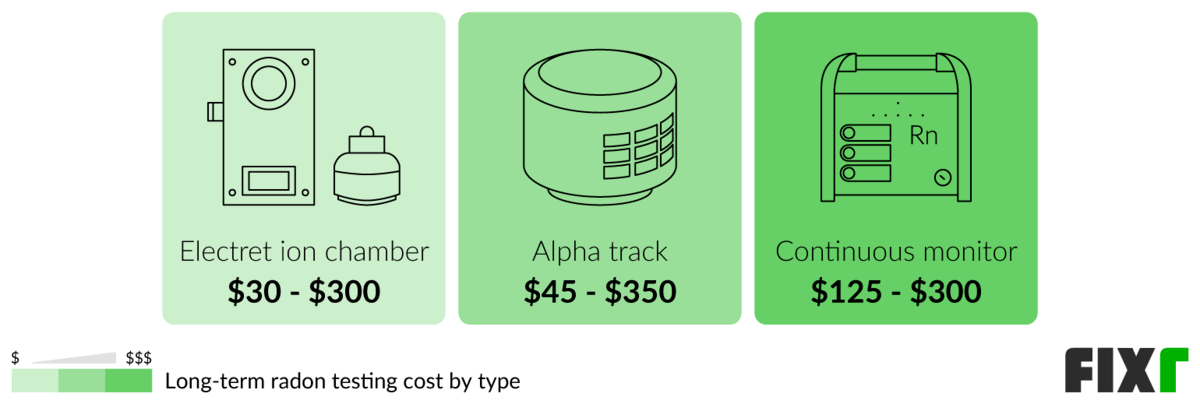

| Type of Long-Term Testing | Cost |
| Electret Ion Chamber | $30 - $300 |
| Alpha Track | $45 - $350 |
| Continuous Monitor | $125 - $300 |
Electret Radon Monitor
Electret ion chambers cost $30 to $300, depending on the type, size, and setup. An electret radon monitor, also called an electret ion chamber or detector, is another radon testing device suitable for short and long-term testing. It can be set up in a part of the property, usually on the lowest level, and checked after a time to calculate the estimated radon levels. Using several at once is common, placed strategically around the home. Professionals can check them at various points for more accurate test results, but the homeowner can also place them.
Alpha Track Radon Detector
Alpha track radon detectors cost $45 to $350. This is one of the most commonly used detectors by professionals, particularly for long-term use. An alpha track radon detector consists of a sheet of plastic that gets gradually marked and etched when radon is present. This can be an effective and affordable option for long-term radon testing, and it is simple to set up an alpha track or have a professional prepare it.
Continuous Radon Monitor
Continuous radon monitors cost $125 to $300. A continuous radon monitor is an example of an active radon testing device, meaning it needs power to function. They can also be complicated to install and understand, so they are usually best left to the pros. Unlike other short-term forms of radon testing, which are designed to be completed and analyzed in a few days, these monitors stay in your home for weeks or months. These devices can pinpoint small fluctuations in radon levels that other units may miss.
Professional Radon Inspection
Professional radon inspectors use different methods to check for radon in your home and usually charge between $100 and $400 for their services. You may prefer to have a professional radon inspector come to your property and do the tests themselves if you are worried about accuracy or mistakes. You should also have a professional come out for testing if you purchase or sell a property or the DIY kit has returned a borderline high result. With professional testing, an experienced and qualified radon inspector visits your home and sets up the tests, reducing the risk of errors.
Professional inspectors may also use more advanced testing equipment than the at-home kits, improving overall accuracy. They handle everything from property inspection and test setup to lab analysis. The more visits they make to check on the tests and the more tests used at once, the higher your total costs.
Most professionals test the air on your property, but if you have a well, they generally do a one-time test for this also. Because professionals understand the gas, they are more likely to know where to test, such as near cracks in the foundation or areas that are least likely to be disturbed or have high airflow that could disrupt the test.
Home Inspection and Radon Testing
Radon testing is often recommended when additional home inspection services are also recommended. This includes when buying or selling a home or when you notice other issues like foundation cracks or significant wood rot caused by insects that may warrant further inspection. Some companies offer home inspection, radon testing, and other testing for other hazardous materials like asbestos, mold, and insects like termites.
You can request radon testing when you hire a home inspection company for buying or selling a house or major remodels or repairs. The home inspection company does the testing in many cases, while a few companies may contract out. You can sometimes get better pricing by combining the services because you are bundling. While home inspection costs average $300 to $500 for whole-home inspections and radon testing averages $150 to $350, you can sometimes get a break on the combined testing when you do them through one company rather than doing each service separately.
What to Do if Radon Radon Levels Are High
If short or long-term radon tests show you have high radon levels, take action immediately. The EPA recommends that action be taken in any home or building where radon levels of 4 pCi/L or higher are detected and homeowners with levels over 2 pCi/L consider mitigation.
A single test revealing high levels should be repeated. In most cases, have a professional take the second test if the first was DIY to eliminate error. If the second test determines your radon levels are high, you need to work with a radon mitigation company to lower the levels. The same people who do testing often offer mitigation, so speak with the testing company about your options.
While waiting for mitigation, you can open the windows in your home and run fans to increase ventilation. Consider putting down sheet plastic if your basement is dirt and seal large foundation cracks to lower the amount of radon that may be getting through. These measures can help lower levels but are not enough to fully mitigate radon and should not be used in place of true professional mitigation services.
Radon Mitigation System Cost by Type
You may want to consider installing a mitigation system if you have radon levels above 2 pCi/L. You definitely need to install a mitigation system to lower the radon levels if your levels are about 4 pCi/L. Several mitigation systems are available. Not every type works for every home, and some types may be recommended over others, depending on your levels, foundation, and if you have a well. Radon mitigation systems lower the levels of detectable radon in the air and water. Below are the different available systems and the average cost to install them.
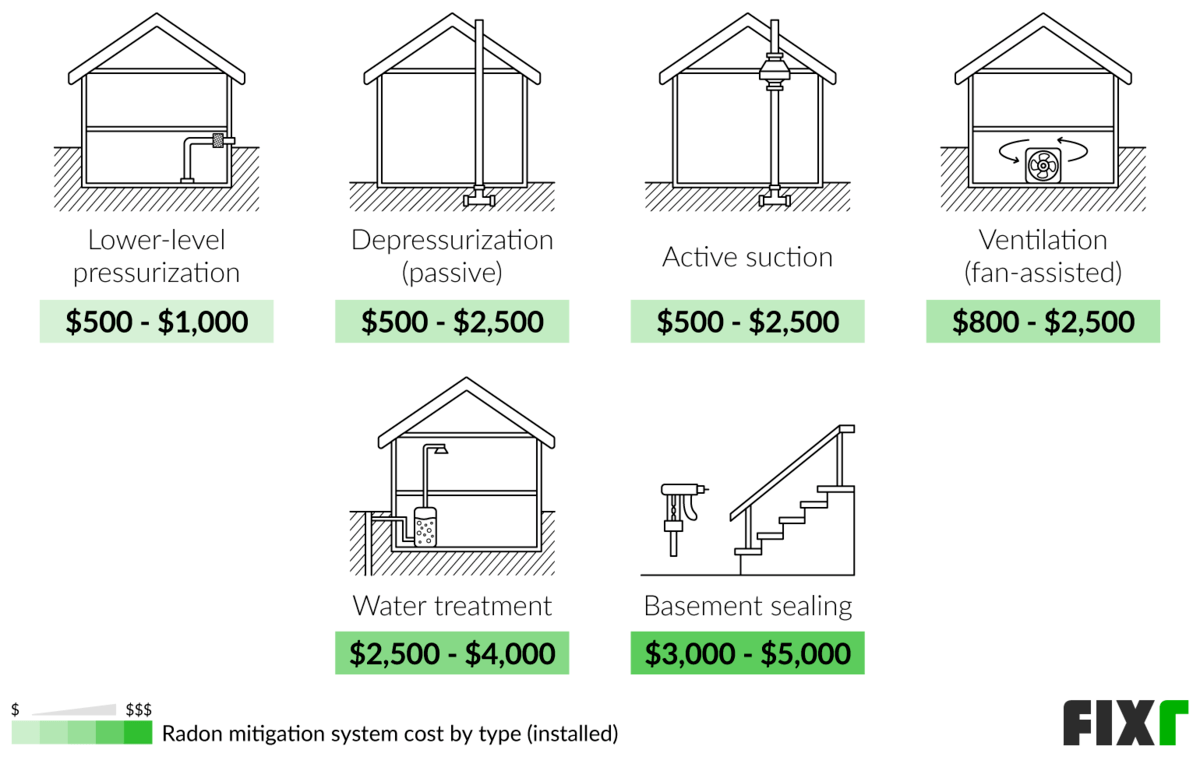

| Mitigation Type | System Cost (Installed) |
| Lower-Level Pressurization | $500 - $1,000 |
| Depressurization (Passive) | $500 - $2,500 |
| Active Suction | $500 - $2,500 |
| Ventilation (Fan-Assisted) | $800 - $2,500 |
| Water Treatment | $2,500 - $4,000 |
| Basement Sealing | $3,000 - $5,000 |
Lower-Level Pressurization
The cost of lower-level pressurization is $500 to $1,000. This might be good to lower the radon if your home is air-tight. Fans increase the pressure in your basement for lower-level pressurization. Because most radon is pulled into the home because of low pressure, you can keep the radon out by increasing the pressure. This method does not work with slab foundations or homes that are not very air-tight. It is most often used in newer homes with basements rather than older homes.
Depressurization (Passive)
Depressurization costs $500 to $2,500 for most homes. Depressurization is sometimes called passive depressurization because it only requires a pipe with no fans, suction, or other parts. This system can be set up in several ways. You can drill directly into a slab or basement foundation and install a pipe extending past your roofline. You can also use your sump pit or French drain system and run the pipe from these above your roofline. The idea is that the pipe collects and vents the radon from the soil before it can enter your home.
Active Suction
Active suction costs $500 to $2,500. This is another depressurization. The difference is the pressure is created beneath the home with air or fans rather than letting the gas escape alone. This method still uses a pipe installed through your slab, basement foundation, sump pit, or French drain. Active suction may be necessary if other methods are not sufficiently lowering the levels of radon gas.
Ventilation (Fan-Assisted)
Fan-assisted radon mitigation with ventilation costs $800 to $2,500. This system is often used in basements. The system begins with active depressurization but needs ventilation to replenish the air pushed out of the basement. Ventilation keeps fresh air circulating through the area while the radon is removed. This is helpful for furnaces and water heaters and helps prevent back-drafting. This is not needed in every active depressurization and depends on the home.
Radon Water Mitigation
Radon water mitigation costs $2,500 to $4,000. Water mitigation systems generally work by running the water through a special holding tank before it reaches the faucets and outlets in your home. This can mean running the water through charcoal or, more commonly, by air stripping. In this last method, bubbles are pushed through the water, causing the radon to rise to the surface where it can be vented harmlessly outside. These tanks are large and use ample space in your basement or utility closet.
Basement Sealing
Basement sealing for radon mitigation costs $3,000 to $5,000. Basement sealing means filing foundation cracks and sealing the concrete with a radon barrier. This system is not effective alone and is rarely used by itself. Instead, basement sealing may be used with other radon mitigation methods in areas with high radon levels. Because basement sealing can make the area air-tight, you could install a lower-level pressurization system after sealing the basement. Basement sealing could be enough to keep low radon levels at bay so that no further mitigation is needed in some cases. However, this is rare and not recommended for most homes.
How Does the Foundation Type Affect Radon Mitigation?
Radon mitigation does not change tremendously based on your foundation, with size and radon level being the biggest cost factors. However, the mitigation system may have additional costs if you have a dirt foundation or an older crawl space. Dirt foundations and dirt floors beneath crawl spaces must be sealed before radon mitigation. This is done with plastic sheeting that is caulked and sealed around the edges. Costs for this vary from $300 to $1,000, depending on the area. There are additional costs after sealing the dirt foundation for the mitigation system.
Radon Health Effects
Radon can pose serious health risks to those exposed to it in high amounts, which is true for smokers and non-smokers. People of all ages and backgrounds have a higher chance of developing lung cancer due to radon exposure.
Estimates from the EPA suggest that radon is the leading cause of lung cancer in the United States in non-smokers, leading to around 21,000 lung cancer deaths annually. Those who smoke are at an even greater risk of developing this disease because their lungs are already weakened from cigarette or tobacco usage.
The CDC confirms that radioactive particles from the gas can get stuck inside your lungs when you inhale radon, increasing the risk of cancer. It might take years of regular exposure to radon for a person to develop obvious symptoms or health issues. However, it is clear that this gas increases the risk of cancer, with several studies backing this up.
DIY Radon Testing Tips
If you do radon testing on your own, act with care and precision to reduce error. Read the instructions carefully and contact the manufacturer if you have questions or find the instructions unclear. The EPA recommends keeping all windows and doors closed for a minimum of 12 hours before the test and avoiding short-term tests during storms or windy conditions. Place the test device 20” or more above the floor in an area free of drafts, radiators, exterior walls, or other disturbances. Note the test’s start time and date and end time and date before sending it for analysis.
Additional Considerations and Costs
- Price vs demand. The costs of professional radon inspection vary greatly, depending on where you live. Places with active real estate markets often have higher inspection and testing costs because there is greater demand.
- Test location. The EPA and Surgeon General agree that radon testing should occur below the home’s third floor. Most tests are designed for the lower levels of a home or building.
- Where to ask. If you are unsure of which short-term device or test to choose or have other questions, contact your local state radon office for more information.
- DIY. When planning DIY renovations around the home, test the area beforehand and consider how your work might affect the radon levels. If you make mistakes, you can increase the amount of radon on your property. This is especially true when working in the basement, so you may want to hire a professional.
- Time. The time it takes for radon testing varies greatly. You can find tests that give you results in a few days and others that need months to provide accurate readings.
- Travel fee. Some professionals may have a travel fee. This is often true if they need to make repeated trips to your home for analysis. This fee can be $50 to $100, depending on the area.
- Radon-resistant new construction (RRNC). If your home was built after 2010, it might have been built with radon-resistant new construction. This means radon mitigation may be built into the home from the beginning. This is standard and required in many states where radon levels are high. You can check with your state to determine if this is a requirement in your area.
FAQs
- How serious is radon gas to my health?
Excessive amounts of radon gas can be a serious threat. This gas can drastically increase one’s risk of developing lung cancer in high quantities, as confirmed by the EPA and CDC.
- Who does radon testing?
You can hire professional radon testing companies to inspect your property and do tests, or you can do part of the test and send your test kits and devices to labs for analysis.
- Can my radon inspector also remove the gas?
Some radon inspection companies also offer radon mitigation services, but others specialize in testing for the presence of the gas.
- Do open windows help get rid of radon gas?
Opening windows can temporarily lower the radon in your home, but radon levels return to their usual rates within half a day when you close them again, so this is not a viable long-term option.
- Do new homes have radon systems?
Yes, new homes can be built with radon-reduction systems and radon-resistant materials. This is required in new construction in some states with high radon levels. The EPA recommends talking to your builder about radon-resistant materials and options to find out more.
- Are radon inspections necessary?
Radon can lead to lung cancer risks for those living or working in a building. So, it can be important to have an inspection, especially when moving to a new home or doing renovation work.
- Is it OK to live in a house with radon?
High levels of radon can lead to lung cancer over a long period. Therefore, you should install a radon mitigation system if your home has high radon levels.
